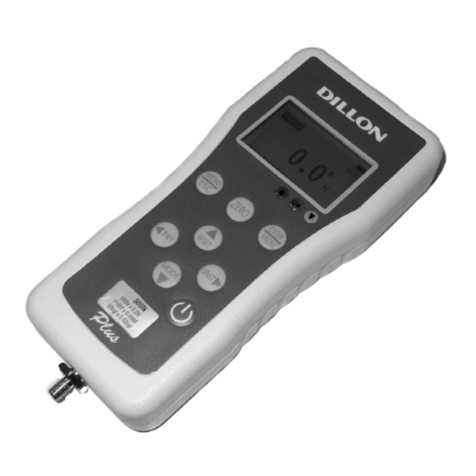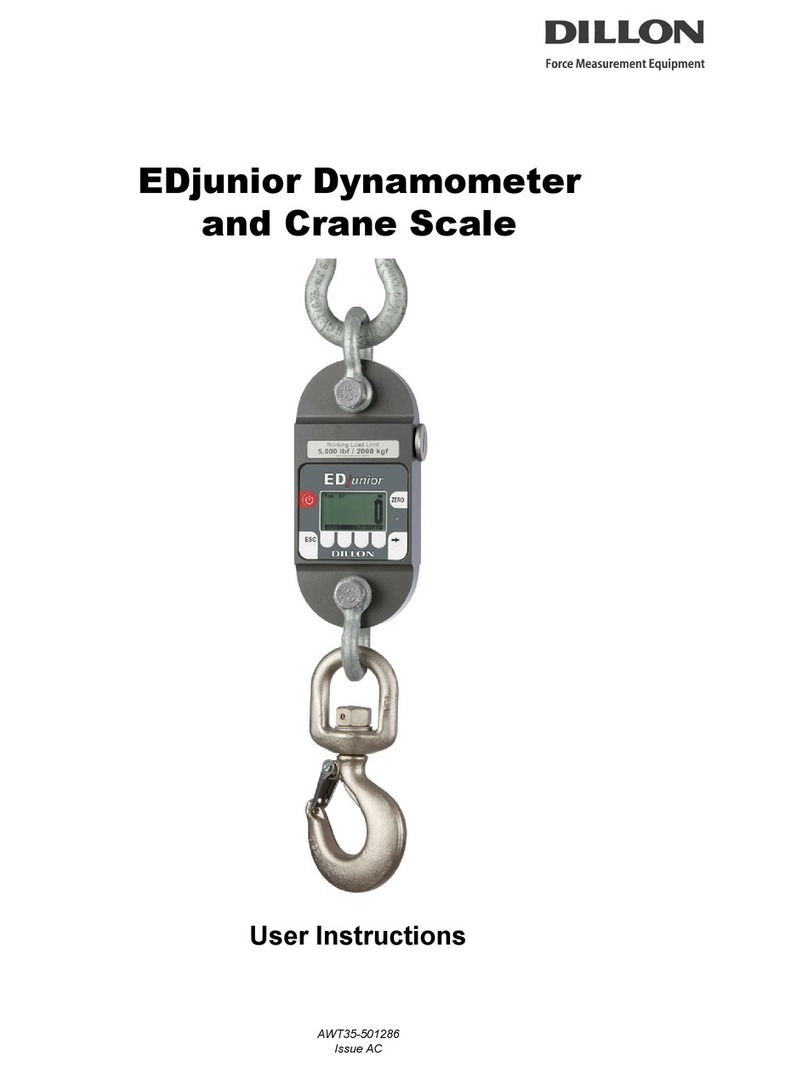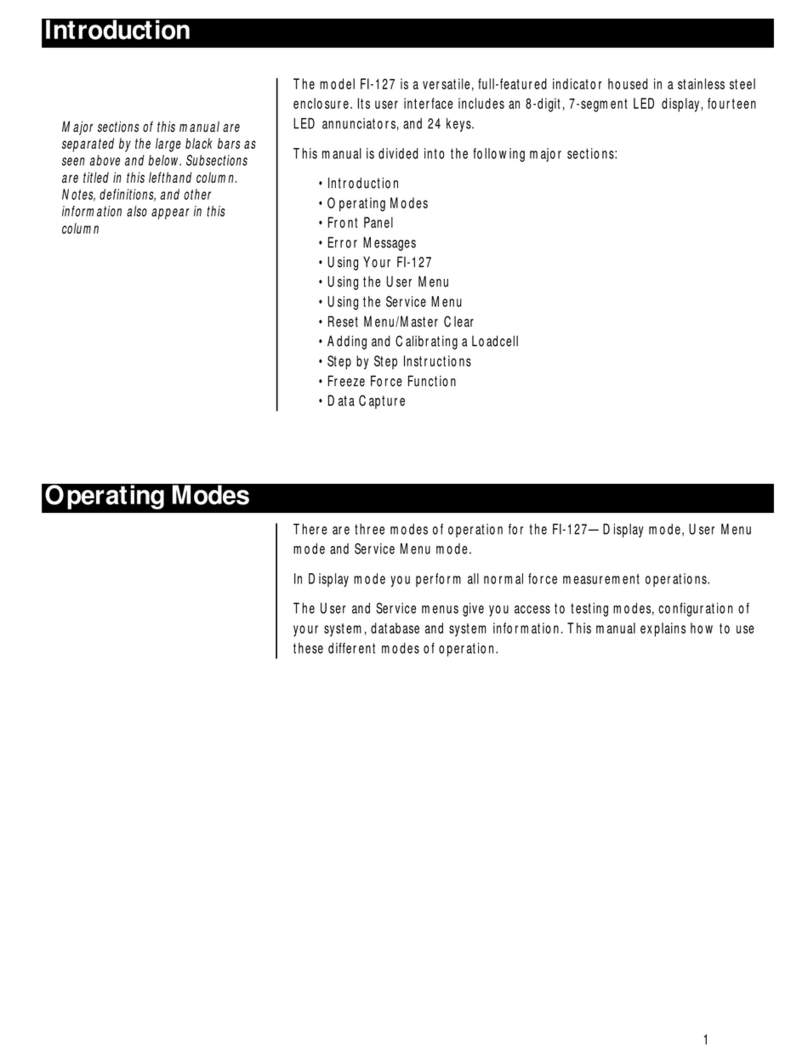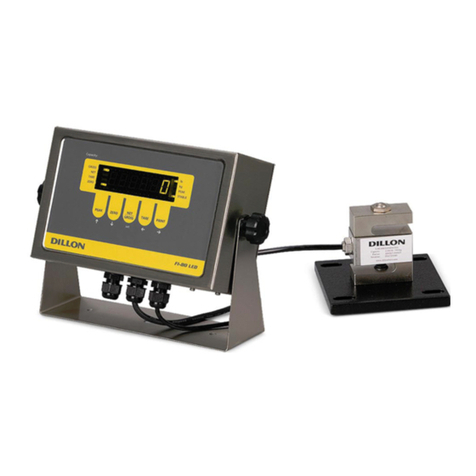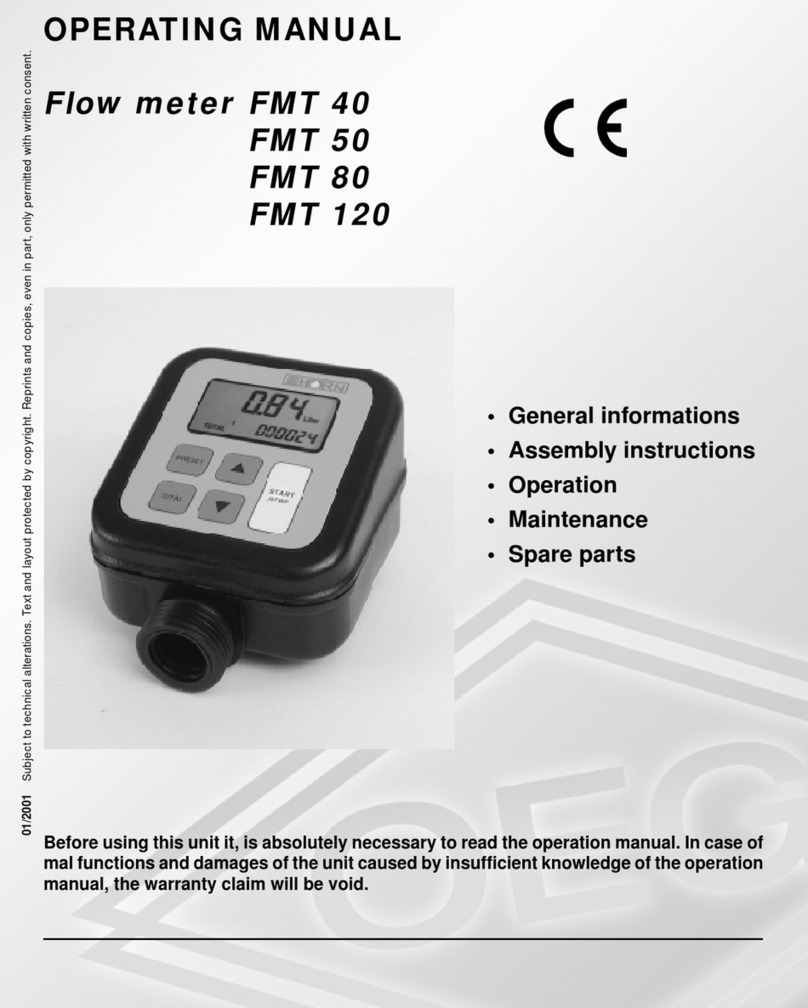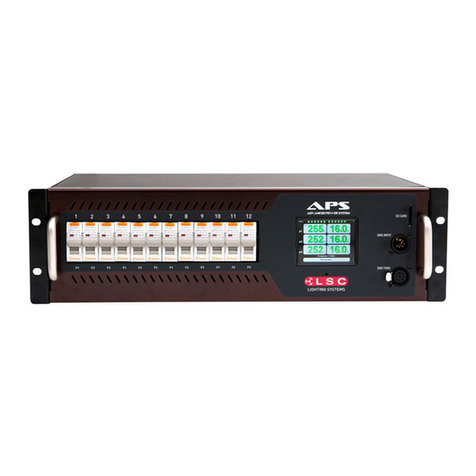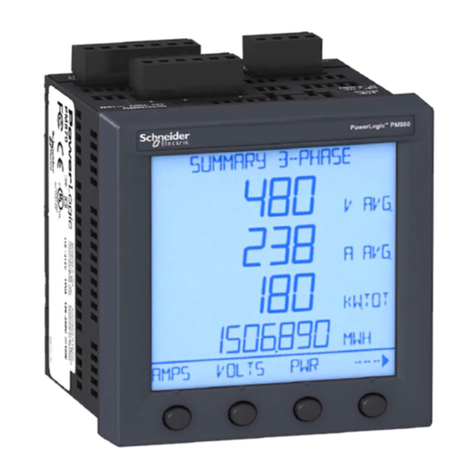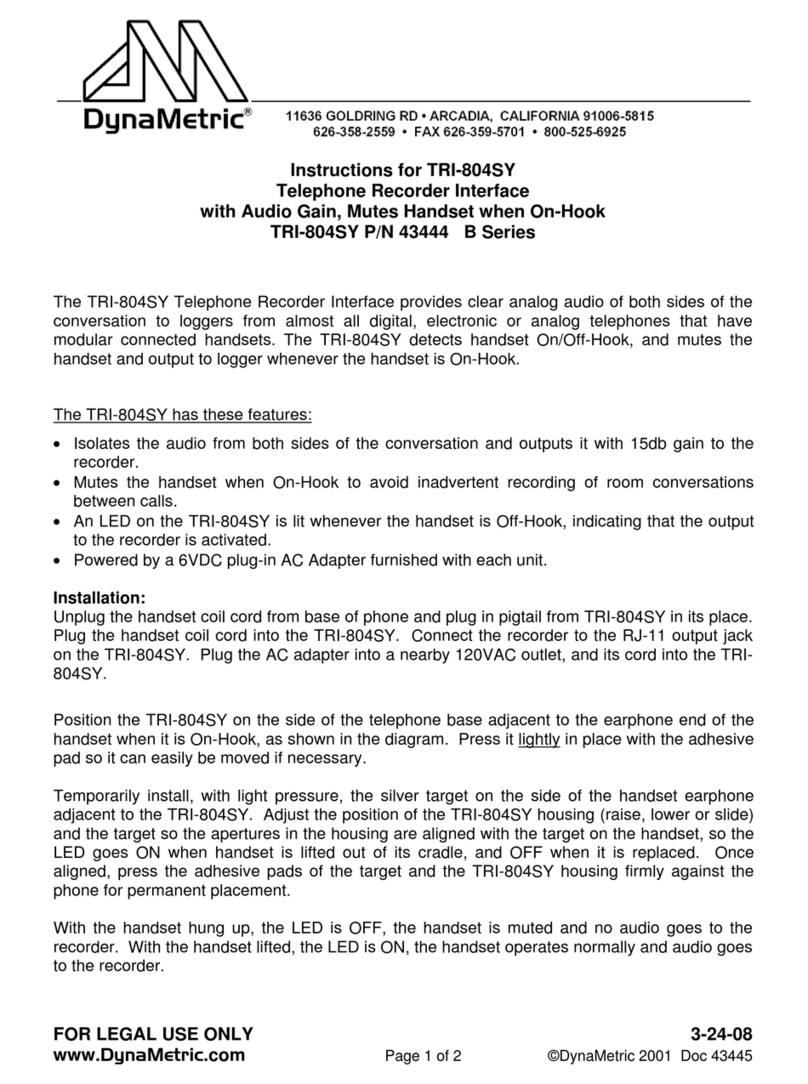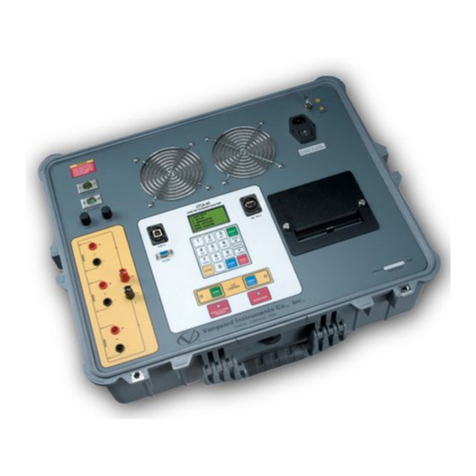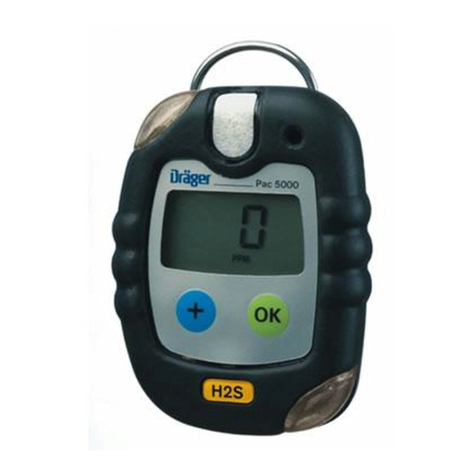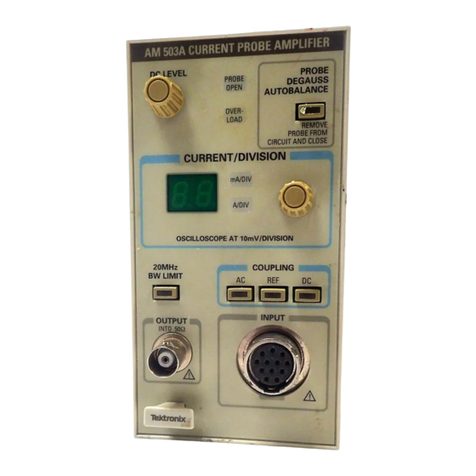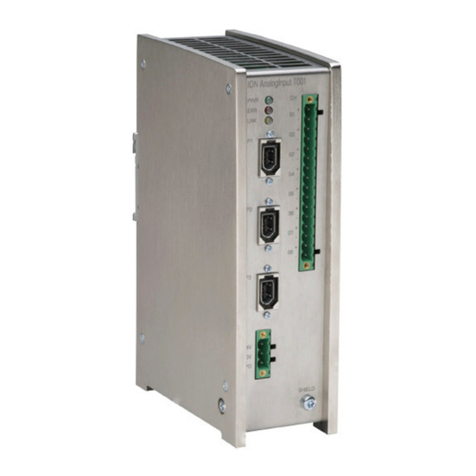Dillon ED-2000plus User manual

ED-2000plus Electronic Dynamometer
with HR-2000 Remote
User’s Manual

2
03/17/04 ED2000_U.P65 PN 29641-0012F e3 Printed in USA
Risk of electrical shock. Do not remove cover. No user service-
able parts inside. Refer servicing to qualified service personnel.
Weigh-Tronix reserves the right to change
specifications at any time.
CAUTION
EUROPEAN COUNTRIES
WARNING
This is a Class A product. In a domestic environment this product may cause radio
interference in which the user may be required to take adequate measures.

3
Table of Contents
Table of Contents ............................................................................................ 3
Specifications ................................................................................................. 4
ED-2000plus Introduction ................................................................................ 5
Normal Operation Mode ....................................................................... 6
RS-232 Operation ................................................................................ 7
Device Information Mode ...................................................................... 8
Configuration Mode .............................................................................. 9
Disabling the Radio-Link Software to Save Battery Power ........ 10
Sleep Mode .............................................................................. 10
Battery Replacement .......................................................................... 11
HR-2000 Introduction and Operation .............................................................. 12
Introduction ......................................................................................... 12
Addresses .......................................................................................... 12
Operation ........................................................................................... 13
Powering Up ....................................................................................... 13
For Radio Communication ........................................................ 13
Radio Operation with RS-232 ............................................................. 14
For Wireline Communication ..................................................... 15
Addressing Mode ............................................................................... 15
Appendix - Weighing and Force Measurement Practice ................................ 18
Load Centering ................................................................................... 18
Good Pin Fit ....................................................................................... 18
Torque and Bending ........................................................................... 18
Certified Gear ..................................................................................... 18
Safety ................................................................................................. 18
Good Force Measurement Practice .................................................... 19
—This manual is for reference only.—
Pages are numbered consecutively beginning with the cover page.

4
2,000 x 0.5 lb 1,000 x 0.2 kg 10 x 0.002 kN 1 x 0.0002 T
5,000 x 1 lb 2,000 x 0.5 kg 20 x 0.005 kN 2 x 0.0005 T
10,000 x 2 lb 5,000 x 1 kg 50 x 0.01 kN 5 x 0.001 T
20,000 x 5 lb 10,000 x 2 kg 100 x 0.02 kN 10 x 0.002 T
50,000 x 10 lb 20,000 x 5 kg 200 x 0.05 kN 20 x 0.005 T
100,000 x 20 lb 50,000 x 10 kg 500 x 0.1 kN 50 x 0.01 T
Aluminum alloy (2-, 5-, and 10,000 lb)
Stainless steel (20-, 50-, and 100,000 lb)
NEMA 4X / IP66 (sealed against dust, hosedown, and corrosive agents)
Selectable pounds, kilograms, kiloNewtons, metric tons. The selected unit of
measure is saved when the power is switched off.
0.1% of rated capacity
0.1% of rated capacity
2 times per second
Normal mode: 8 times per second
Peak hold: 60 times per second
5:1
6 LCD digits, 0.9" (22.5 mm) height
RS-232 output from dynamometer or Radio-Link remote display unit.
LB, KG, KN, TONN, PH (peak hold), BAT (low battery)
On/Off, Test, Clear/Zero, Peak hold, Function key, Units
Standard 9V battery, alkaline or lithium. The ED-2000plus has approximately
200 hours of use with the 9V alkaline battery. Battery life can be extended
with the use of a 9V lithium battery. These values represent “average” use;
mode of operation, typical period of use, battery recovery, and other variables
determine the ultimate battery life. With the optional radio link installed, the
9V battery life is approximately 36-48 hours.
-4° to 140°F (-20° to 60°C)
Traceable to the National Institute of Standards and Technology (NIST).
Calibration Certificate with each unit.
Open air range: Up to 300 feet
Update rate: 2 times per second
RF signal output: 0 dBm in 50 at 25 C in accordance to FCC Part 15.249,
and in Canada under TRS RSS-210.
Frequency: 916.5 MHz
ED-2000plus Specifications
Capacities:
Construction:
Enclosure:
Units of measure:
Accuracy:
Repeatability:
Display update rate:
Internal update rate:
Ultimate safety factor:
Display:
Outputs:
Annunciators:
Control keys:
Power:
Operating temp:
Calibration:
Optional Radio link:

5
ED-2000plus Introduction
The ED-2000plus dynamometer is an electronic portable force or weight
measurement instrument.
The ED-2000plus is available with low-power radio communications. This
option permits wireless communication between the ED-2000plus and an
HR-2000 handheld remote display. The ED-2000plus system offers additional
flexibility by the ability to have several (up to 255) devices controlled by a
single HR-2000 display. This is called a multidrop system.
Data can be extracted from either the ED-2000plus or the HR-2000. This data
can be sent to a computer by pressing the DATA SEND key or requested by
the computer by sending an ENQUIRE code.
This guide describes the operation of the ED-2000plus series of Dillon elec-
tronic dynamometers and the procedures for configuring the device to your
specific needs.
The display consists of six 7-segment digits and six annunciators which
appear when appropriate. See Figure 1 below.
There are three modes of operation:
• Normal operating mode, which covers the daily use of the device.
• Device information mode, allows information about the device to be
viewed but not edited. Information that can be viewed includes serial
number, range, date of last calibration, etc.
• Configuration mode, which enables the user to configure the device.
Figure 1
Electronic Dynamometer Front Panel
The ED-2000plus is not suit-
able for use in magnetic
environments.

6
Shows the current gross value with the
appropriate annunciator visible (LB, KG,
KN or TONN). With Version 3.0 software
the display will show OFF 3A when turning
the unit off.
Reads net force value. Can be positive or
negative. Can tare up to 100% of capacity.
No change in the display.
Shows the gross force value.
The units legends will change in the
sequenceLB->KG->KN->TONN->LB etc.,
and the display will update accordingly.
Activates the "PH" annunciator if in peak
hold mode. The annunciators will flash and
the top segment of the left most digit will
illuminate to indicate maximum is being
displayed.
The top segment of the left most digit
illuminates if maximum reading is being
displayed. The bottom segment illumi-
nates if the minimum reading is being
displayed.
A value is displayed that is within ±0.1% of
capacity in the currently selected measur-
ing units. If displayed value is greater than
±0.1%, recalibrate the unit. Depending on
the filter value currently selected (see
Configuration Mode), the display may take
some time to settle to a stable reading.
Hold for ½ second to turn unit on. On start-up
the device is initialized and starts measuring with
previous units selected. ON/OFF key is disabled
in peak hold, device information and configuration
modes.
Tare the device and show net reading.
Send displayed information via RS-232
Not used with the ED-2000plus
Reverts to gross reading.
Scrolls through the four possible units of mea-
sure and converts the reading to the selected
unit. Selected unit of measure is saved when
power is switched off.
Toggles the device between normal and peak
hold mode. In peak hold mode it will update the
reading at 60 times per second.
If the device is in peak hold mode, toggles
between minimum and maximum readings.
Performs an internal shunt test of the measuring
bridges. (You must hold the key down until the
display stabilizes.)
Switches device from normal operating mode to
device information mode.
Switches device from operating mode to configu-
ration mode.
Puts device in RS-232 mode. This function also
conserves battery life. If you are not using the
radio function, we recommend placing the device
in RS-232 mode.
ON/OFF
CLR/ZERO
SEND DATA
ALT
F+CLR/ZERO
UNITS
F+PEAK
HOLD
PEAK HOLD
TEST
F+UNITS
F+TEST
F+ON
(from power
off)
Normal Operation
Mode
Key Function Display
Table 1
Key Functions in Normal Operation Mode
During normal operation mode most of the basic functions are available by
pressing one key. Some of the functions require that the F-key is pushed
simultaneously. This is indicated by F+[key]. Table 1 explains the key
functions.

7
RS-232 Operation You can operate the ED-2000plus with a computer or other data logging
device via RS-232. To place the ED-2000plus in RS-232 mode, use one hand
to press and hold the F key and use the other hand to press the ON key.
This operation is transparent to the user. It is important that the ED-2000plus
and the external device are set at a baud rate of 2400 for RS-232 communica-
tion.
When you press the DATA SEND key in RS-232 mode, or send an enquire
code from the external device to the ED-2000plus, the following information is
sent to the external device:
xxxxx.x uu CR/LF
x= force value
u= unit of measure (LB, KG, KN or T)
CR/LF = carriage return and line feed
The enquire code is a single question mark (?). When the ED-2000plus
receives this code from the external device, the above information is sent.
If your RS-232 port is receiving garbled data, check to be sure you are in
RS-232 mode or that an HR-2000 is not trying to communicate with the
ED-2000plus by radio.
The force value received is right
justified with any leading zeroes
replaced by spaces. Negative
values will show a minus sign
before the first digit. The
decimal point will not be printed
if it follows the significant
digits.

8
To acitvate the device information mode from normal operating mode use one
hand to press and hold the F key and use the other hand to press the UNITS
key. Return to normal operations by using one hand to press and hold the F
key and use the other hand to press the CLR/ZERO key.
Upon entering device information mode, the selected unit annunciator will
flash (indicating that the device is out of the normal operating mode) and the
display will show the device serial number. Use the keys described in Table 2
to view the information fields described in Table 3.
Device Information
Mode
The "label" for the field is shown briefly
when the key is kept depressed. The
actual information value is then shown.
Same as for PEAK HOLD
Same as for PEAK HOLD
Scroll down the list of information fields, i.e. the
next field in the list.
Scroll up the list of information fields, i.e. the
previous field in the list
Show the label of the current information field.
Return to normal operating mode.
PEAK HOLD
TEST
UNITS
F+CLR/ZERO
Key Function Display
Table 2
Key Function in Device Information Mode
The device serial number (6 digits).
Load element number.
The software release number.
Device range in 1,000s of pounds.
Year, Month and Day of last calibration.
Reference to calibration document number (6 digits).
Total number of calibrations performed.
Number of times the device has been overloaded beyond 125% of full
capacity.
The communication address assigned to the device in multidrop
applications.
SErno
Eltno
SoFt
rAnGE
C-dAt
C-rEF
C-cnt
OLOAd
Addr
Label Typical Display Description
512056
201360
2.60
201Lb
96.08.02
100123
3
0
100
Table 3
Device Information Fields
Table 3 contains the information fields and typical values you can view in the
device information mode. The fields appear in the sequence shown. Scrolling
past the last item in the list will return the display to the first item in the list.

9
To activate the configuration mode from normal operation, use one hand to
press and hold the F key and use the other hand to press the TEST key.
Return to normal operations by using one hand to press and hold the F key
and use the other hand to press the CLR/ZERO key.
Upon entering configuration mode, the selected unit annunciator will flash
(indicating that the device is out of the normal operating mode) and the
display will show the current value for setpoint 1.
The configuration values may be changed and permanently stored in nonvola-
tile memory within the device. Consequently, use these functions with care.
Note that the values will be changed immediately in the EEPROM, but some
changes will only take effect when the unit is switched off and then back on.
These values are noted with an asterisk in the "Label" column of Table 5
Table 4 shows the keys you use to set configuration to your needs. Table 5
contains the configuration items you can view and change.
Table 5 contains the information fields and typical values you can view in the
configuration mode. The fields appear in the sequence shown. Scrolling past
the last item in the list will return the display to the first item in the list.
Configuration Mode
Key Function Display
The "label" for the field is shown briefly
when the key is kept depressed. The
actual information value is then shown.
Same as for PEAK HOLD.
Same as for PEAK HOLD.
Dependent upon function selected.
Dependent upon function selected.
Scroll down in list of information fields, i.e. the
next field in the list.
Scroll up in list of information fields, i.e. the
previous field in the list.
Show the label of the current information field.
Increment the value shown with wraparound.
Decrement the value shown with wraparound.
Return to basic function mode.
PEAK HOLD
TEST
UNITS
F+PEAKHOLD
F+TEST
F+CLR/ZERO
Table 4
Key Functions in Configuration Mode

10
Typically not used.
Typically not used.
Filter values (damping factors) on the load cell signal. Acceptable
values are from 0 (no damping) to 7 (maximum damping).
Changes the serial communication link between RS-485 and radio
link. Press F + TEST key to toggle between the two choices. Select
RS-232 communication by depressing F+ON/OFF at power up and
RS-485 and radio will be bypassed.
The communication address assigned to the device in multidrop
applications. Values should be between 33 and 255.
Communication baud rate. Available values are 300, 1200, 2400,
4800, 9600, and 19,200 baud. System default is 2400 baud. Radio
communication at 2400 baud by default.
SEt-1**
SEt-2**
FiLt
SErch*
Addr*
bAud*
Label Typical Display Description
100
110
2
rS-485
rAdio
100
2400
*Change takes effect only after the unit has been switched off and then back on.
** Used only in special software applications
Table 5
Configuration Items
Sleep mode is a non-configurable battery saving feature of the ED-2000plus. It
functions all the time. If signal changes from the strain gages are not received
by the microprocessor, certain high drain functions are shut down. The
display does not change and any communication with the unit or signal from
the gages reactivates the unit instantly. The function of the sleep mode is
transparent to the user.
The ED-2000plus software allows you to use the Radio-Link option. If the
Radio-Link option is installed but not being used, disable the radio portion of
the software to increase battery life. Also, if your system is not equipped with
the Radio-Link option, disable the software.
To disable the Radio-Link software see the SErch section in Table 5 below.
Notice that the change will not take effect until the ED-2000plus has been
switched off and then back on.
Disabling the Radio-Link
Software to Save Battery
Power
Sleep Mode

11
When the low battery annunciator appears, you have approximately five hours
of usage left. To change the nine-volt battery in the ED-2000plus, follow these
steps:
1. Remove the two knurled thumb screws from the battery compartment
cover. (Be careful not to lose these screws.) See Figure 6.
Figure 6
Battery compartment cover
2. Remove the battery compartment cover.
3. Slide the battery down and pry the free end of the battery out of the
compartment opening. See Figure 7.
Figure 7
Battery removal
4. Pull the battery out of the compartment and disconnect the battery from
the battery lead.
5. Connect new battery to the lead and reverse the disassembly procedure.
ED-2000plus connected to
an HR-2000 by wire
receives power from the
HR-2000. A battery is not
recommended in the
ED-2000plus in this
situation.
Battery Replacement
The HR-2000 does not contain
a low battery detector. It merely
displays the low battery warning
from the loadcell. Because of
this, change batteries in both
the ED-2000plus and HR-2000
when the battery warning lights
up. (Radio-Link systems only)

12
HR-2000 Introduction and Operation
To reduce battery drain when
not using the Radio-Link option,
with the HR-2000 unit on, press
both the PEAK/HOLD and the
ON/OFF key. This disables the
radio portion of the software
and will increase battery life.
Introduction
Addresses
High frequency signals are
subject to absorption by the
ground and the atmosphere, as
well as reflections from metallic
surfaces. For low power sys-
tems, it is normal that varia-
tions of range will be experi-
enced, even in “open air”
conditions in different environ-
ments. Due to combinations of
absorption and reflection,
pockets with weak and strong
signals will be experienced
inside the range.
The dominant absorption factor
is the ground. As a general
rule, the higher the antennas
are above the ground, the
better the signal.
The HR-2000 operates as a remote keyboard and display for the ED-2000plus
electronic dynamometer. Communication between the HR-2000 and the
ED-2000plus takes place in RS-485 format via cable or low power radio
communication.
The HR-2000 has the following communication parameters "hardwired" into
the device.:
• Communication mode: RS-485 half duplex
• Baud rate: 2400 bits per second
• Own address: Configurable
• Initial remote address: Last address used
Addresses are important with the ED-2000plus and HR-2000 because of the
manner in which they communicate. The HR-2000 sends out a signal (poll
signal) requesting that the instrument with a specific address send its display
reading. The ED-2000plus looks at the poll signal that the remote sent and
determines if the address matches. If it does match, the ED-2000plus re-
sponds with its reading.
The concept of addresses is relatively transparent if the system consists of a
single ED-2000plus and an HR-2000. The system will communicate with little
(if any) addressing ever required. However, if several ED-2000plus instruments
are in the same area, they each need to be uniquely identified so that the
HR-2000 knows which ED-2000plus it is talking to.
If several HR-2000 remotes are in the same area, each remote needs to know
when it is its turn to use the airwaves. This is also accomplished by assign-
ing the remote a unique address, and by telling it how many other remotes
are in the area.
The following pages describe the operation of the HR-2000, both in one-on-
one and multiple applications.

13
Turns the unit on in radio mode. RS-485 wireline communi-
cation will also function.
Press these two keys to power up the unit in RS-485
wireline mode. This disables radio function and preserves
battery life.
Puts the unit into addressing mode and shows the address
that is to be polled.
Increments the address by 1 count.
Decrements the address by 1 count
Increments the address by 10
Decrements the address by 10
Returns unit to normal display mode.
Turns the unit off
Forces unit into RS-232 mode
Places remote in LISTEN mode. The remote waits for a poll
signal from the attached peripheral, requests the reading
from the ED-2000plus and returns the reading to the periph-
eral.
Press this to save changes and move to the next item.
Hold the UNITS key to see the item name, release it to see
the value.
Key Function Display
rAdio
rS-485
SEtuP-100
101
99
110
90
-donE-
OFF
-duAL-
LiStEn
See Table 7
headings
ON/OFF
F + ON/OFF
(while unit is off)
F+ ON/OFF
(while unit is on)
PEAK HOLD
TEST
F + PEAK/HOLD
F + TEST
F + ON/OFF
ON/OFF
ALT + ON (while unit is off)
F + ALT
UNITS
Table 6
Key Functions for HR-2000
Operation
Powering Up
For Radio Communication
While operating the HR-2000,
the lower part of the leftmost
digit may be observed to flash.
This occurs when the HR-2000
wants to transmit a message
and is waiting for access or for
an answer. Operating under
good radio conditions, this will
be rarely seen.
The key functions for the HR-2000 are listed in Table 6.
To power up for use with the radio link, press the ON/OFF key on the
ED-2000plus then the press the ON/OFF key on the HR-2000.
When you turn on the HR-2000 for radio use, the display will show the
software revision number (probably hr2001), then the word rAdio. Until the
corresponding ED-2000plus is powered up and communicating with the
HR-2000, the letter rwill flash back and forth between inverted and upright.
When communication is established and working properly the display will
mirror the ED-2000plus display and the leftmost decimal point will blink every
½ second. If communication is broken, the display will flash a small o in the
lower left corner of the display. If communications are not resumed within ten
seconds, the display will show rAdio and the letter rwill flash back and forth
between inverted and upright.

14
Radio Operation with
RS-232
You can connect the HR-2000 with a computer or other data logging device
via RS-232. There are two communication modes for the HR-2000; normal
operation mode and listen mode. It is important that the ED-2000plus, the
HR-2000 and the external device all be set at a baud rate of 2400 for RS-232
communication.
In normal operating mode, the ED-2000plus and HR-2000 are in constant
contact and the HR-2000 screen reflects what the ED-2000plus screen
shows. Information can be sent to an external device by pressing the DATA
SEND key on the HR-2000.
In listen mode, the HR-2000 waits to receive an enquire code from the exter-
nal device, polls the ED-2000plus for the information, then returns it to the
external device.
To enter listen mode, use one hand to press and hold the F key and use the
other hand to press the ALT key. In listen mode the display shows the word
LISTEN and keys are nonfunctional.
Following is the format of the information sent to the external device:
xxxxx.x uu CR/LF (if in LISTEN mode, a less than symbol (>), ASCII
code 62, is also sent after the line feed)
x= force value
u= unit of measure (LB, KG, KN or T)
CR/LF = carriage return and line feed
The enquire code for the HR-2000 is a question mark plus a carriage return
(?,CR or ASCII Codes 63,13). When the HR-2000 receives this code from the
external device, the above information is sent.
The action of sending information or polling for information can introduce
delays in communication between the HR-2000 and ED-2000plus.
If your HR-2000 does not automatically detect the RS-232 connection, turn off
the unit, then power up by using one hand to press and hold the ALT key
and using the other hand to press the ON key. This forces the unit into RS-
232 operation.
The force value received is right
justified with any leading zeroes
replaced by spaces. Negative
values will show a minus sign
before the first digit. The
decimal point will not be printed
if it follows the significant
digits.
WARNING!
HR-2000 is intended to send
only force/weight readings.
Although the HR-2000 can
remotely configure an
ED-2000plus, unpredictable
output may result if Print or
Enquire actions occur while the
ED-2000plus is in configuration
mode.

15
To power up for use with wired communication, use one hand to press and
hold the F key and use the other hand to press the ON/OFF key. Powering
up this way will turn off the radio communication and save battery power in
the HR-2000.
When you turn on the HR-2000 for wireline communication, the display will
show the software revision number (probably hr2001), then rS-485. When
communication with the connected ED-2000plus is established the display
will mirror the ED-2000plus display and the leftmost decimal point will blink
every ½ second. If communication is broken with the ED-2000plus, the
display will show a small oin the lower left of the display. If communication is
not resumed within ten seconds the display will show rS-485 and the letter r
will flash back and forth between inverted and upright.
You can set the address for each HR-2000 and ED-2000plus operating in a
given area so that they can work without interference. If several systems are
operating in the same airspace each HR-2000 and ED-2000 must have a
unique address. Since more instruments must share the same airwaves, the
update time for each unit will increase. Approximate times are shown in Table
7.
It is recommended to keep the ED-2000plus instrument addresses at 100 or
higher.
In multiple system environments the remotes must have their Source ad-
dresses and Poll parameters set appropriately. The source address must
start from address 32 and increase sequentially. The poll value must be equal
to the number of HR-2000s in the area.
You need to set the addresses according to the number of systems you have
operating in the area. See Table 7 below for the proper settings.
Addressing Mode
For Wireline Communication
Number of HR-2000 Poll value ED-2000plus Update time
HR-2000s Source address Destination address
2 32 2 100 1 second
33 2 101 1 second
3 32 3 100 1.5 second
33 3 101 1.5 second
34 3 102 1.5 second
4 32 4 100 2 second
33 4 101 2 second
34 4 102 2 second
35 4 103 2 second
Table 7
Addresses for multiple systems

16
To assign the correct address for each part of the system, you must access
the address mode. Follow these steps to access and set the proper ad-
dress.
1. With one hand, press and hold
the F key and use the other hand
to press the ON/OFF key. . . SEtuP is displayed then 100. This is
the Destination address currently
assigned to the ED-2000plus.
2. Increment or decrement the
address number using the keys
described in Table 6 until the
address you want is on the
screen. Remember to follow the recommen-
dations in Table 7.
3. Press the UNITS key to save the
change and move to the next
item in the address mode. . . SourcE is displayed while the UNITS
key is held then the Source address
is displayed when the key is re-
leased. This is the address currently
assigned to the HR-2000.
4. Increment or decrement the
address number using the keys
described in Table 6 until the
address you want is on the
screen. Remember to follow the recommen-
dations in Table 7.
5. Press the UNITS key to save the
change and move to the next
item in the address mode. . . POLL is displayed while the UNITS
key is held then the poll value is
displayed when the key is released.
This value identifies the number of
remotes that may be operating in a
given airspace. This value has a
default of one. Changing the value will
have the effect of increasing the time
between display updates.
6. Increment or decrement the
address number using the keys
described in Table 6 until the
address you want is on the
screen.
Entering a destination address
of 0 will cause the remote to
send a signal called a “Broad-
cast signal”. The first
ED-2000plus that responds with
its value will then be locked in.
The Destination address must
match with the address entered
in the ED-2000plus. This value
has a default of 100.

17
Two special modes can be flagged with the Poll value:
· A Poll value of zero places the remote in Manual Poll mode. The remote
will only poll the instrument when the UNITS key is pressed by the
operator. The ED-2000plus will reply and the HR will display the reading
until the unit is polled again (or until the screen blanks after ten seconds
of non communication). Manual poll mode is designed for situations in
which constant updates are not necessary, to conserve battery life or
reduce airwave clutter.
· A Poll value of 255 places the unit in Monitor mode. The instrument is
completely passive and only ON/OFF or F+ON/OFF keys are functional.
It will need a second HR-2000 operating actively, and the dEStin and
SourcE address must match the active HR-2000 exactly. The passive
HR-2000 will display any traffic FROM the ED-2000 TO the active
HR-2000, as long as it is within receiving distance. Monitor mode is
designed for situations where a second remote is required for the same
ED-2000plus.
7. Press the UNITS key to save the
change and move to the next
item. . . dEStin is displayed while the key is
pressed then the destination value.
You are now back at the top of the
list of items in address mode.

18
Torque and Bending
Appendix - Weighing and Force Measurement Practice
The basis for all electronic force measurement or weighing is measurement of
stress in a loadcell body. To obtain optimal results it is necessary to estab-
lish a few basic rules, otherwise the effect may be a nonlinear or
nonrepeatable response. Read and follow these tips and see the illustrations
on the next page.
For accurate performance the force
acting on the unit must be in line with
the unit. Centering the load is accom-
plished by using the shims on each side
of the load cell so that it is centered on
the shackle pin. See the illustration at
right. The 20, 50, and 100 Klb
ED-2000plus also include spacers
supplied with shackles.
A good fitting pin is important in order to
generate an even stress distribution and
avoid yield stresses. The ED-2000plus
are designed with the recommended
shackle pin hole sizes for the Crosby
shackle capacity. To achieve published
accuracy you must use the shackle
pins and centering spacers provided by
Dillon.
Torque and bending should be avoided.
Use swivels on the lifting wire for
antitorque and avoid side forces.
Certified shackles and lifting gear
should always be used in accordance to
local laws and federal legislation.
Safety is always a concern in overhead lifting and tensioning applications. To
limit your liability always insist upon factory supplied shackles and pins and
factory tested and certified safe optional equipment. All DILLON products are
designed to meet the published Safe Working Load (SWL) and Ultimate
Safety Factor (USF) standards of the United States Military.
Load Centering
Good Pin Fit
Certified Gear
Safety

19
Good Force Measurement Practice

A division of Weigh-Tronix Inc.
1000 Armstrong Dr.
Fairmont, MN 56031 USA
Telephone: 507-238-4461
Facsimile: 507-238-8258
e-mail: [email protected]
www.dillon-force.com
Force Measurement Products & Systems
Dillon
Table of contents
Other Dillon Measuring Instrument manuals
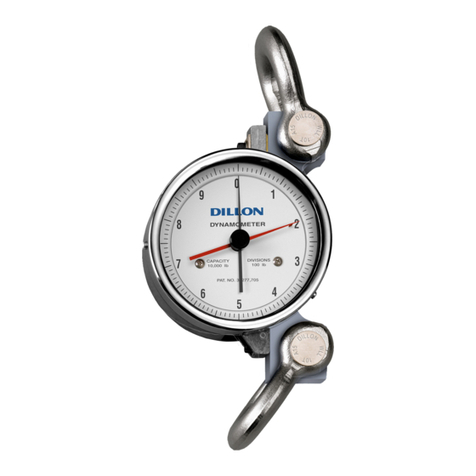
Dillon
Dillon AP User manual

Dillon
Dillon AP User manual
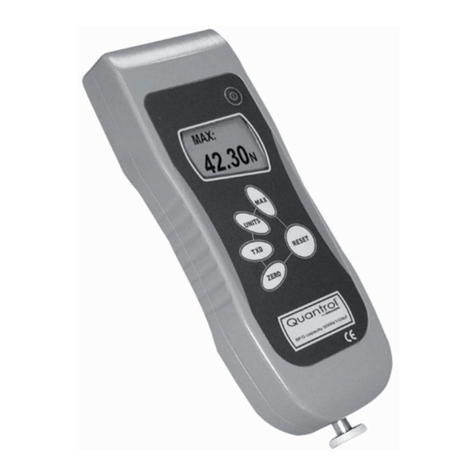
Dillon
Dillon Quantrol BFG 10 User manual
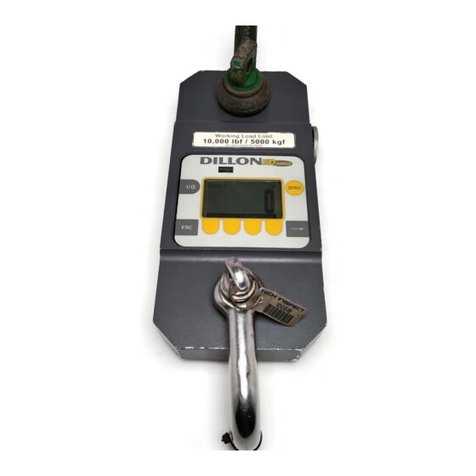
Dillon
Dillon EDjunior User manual

Dillon
Dillon EDXtreme EDX-1T User manual
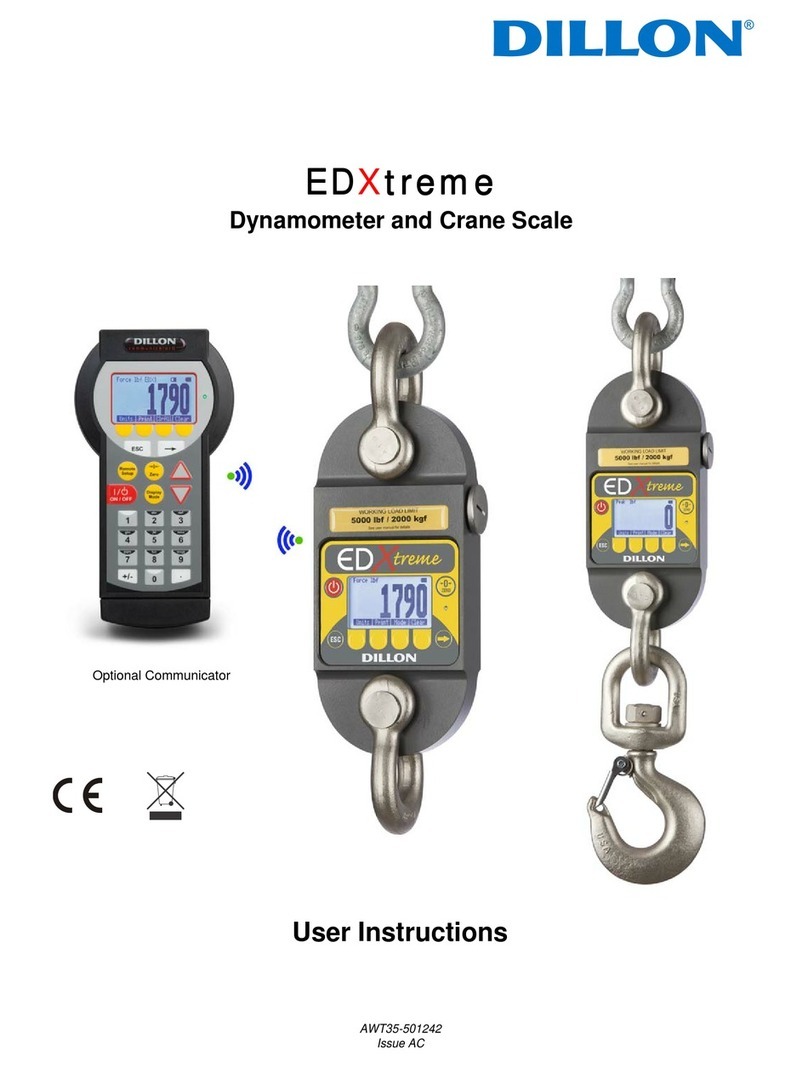
Dillon
Dillon EDXtreme User manual
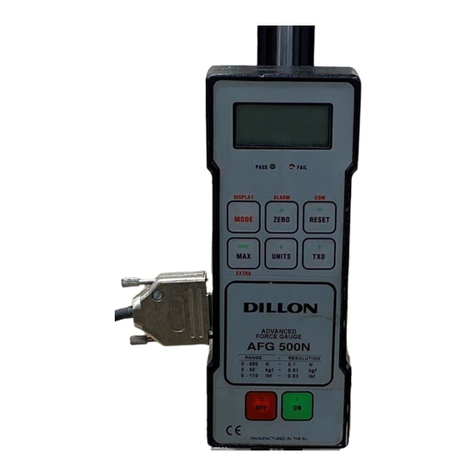
Dillon
Dillon AFG Series User manual
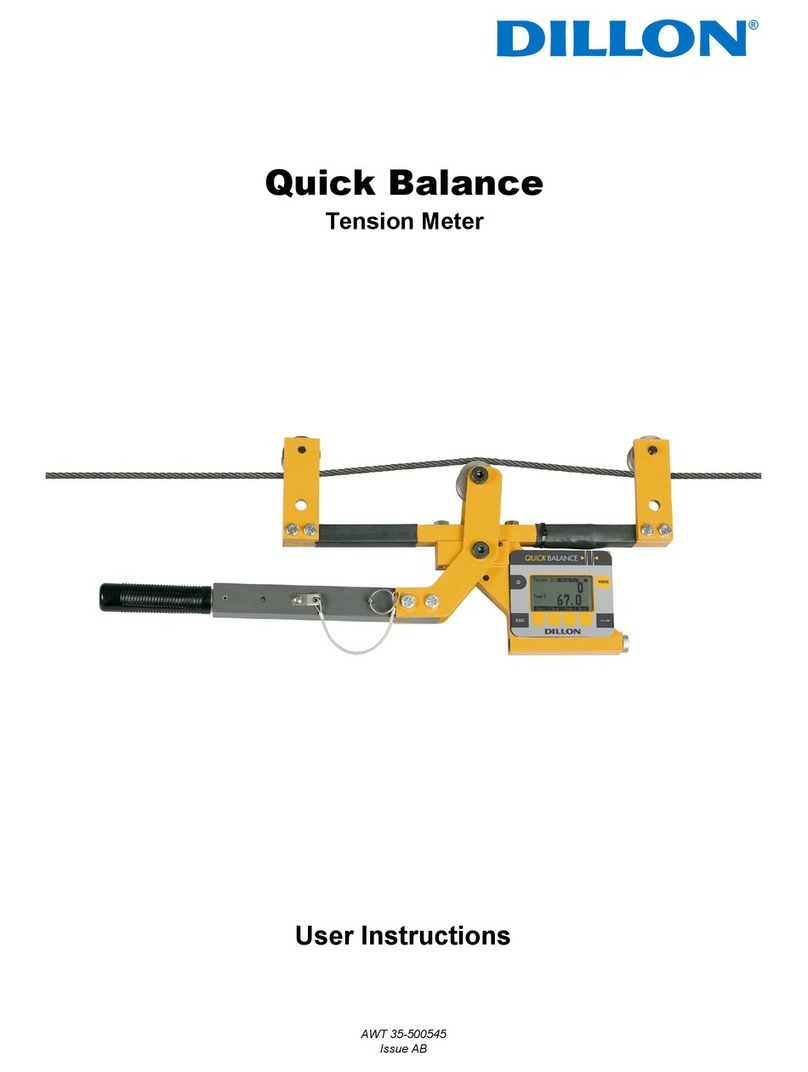
Dillon
Dillon Quick Balance User manual
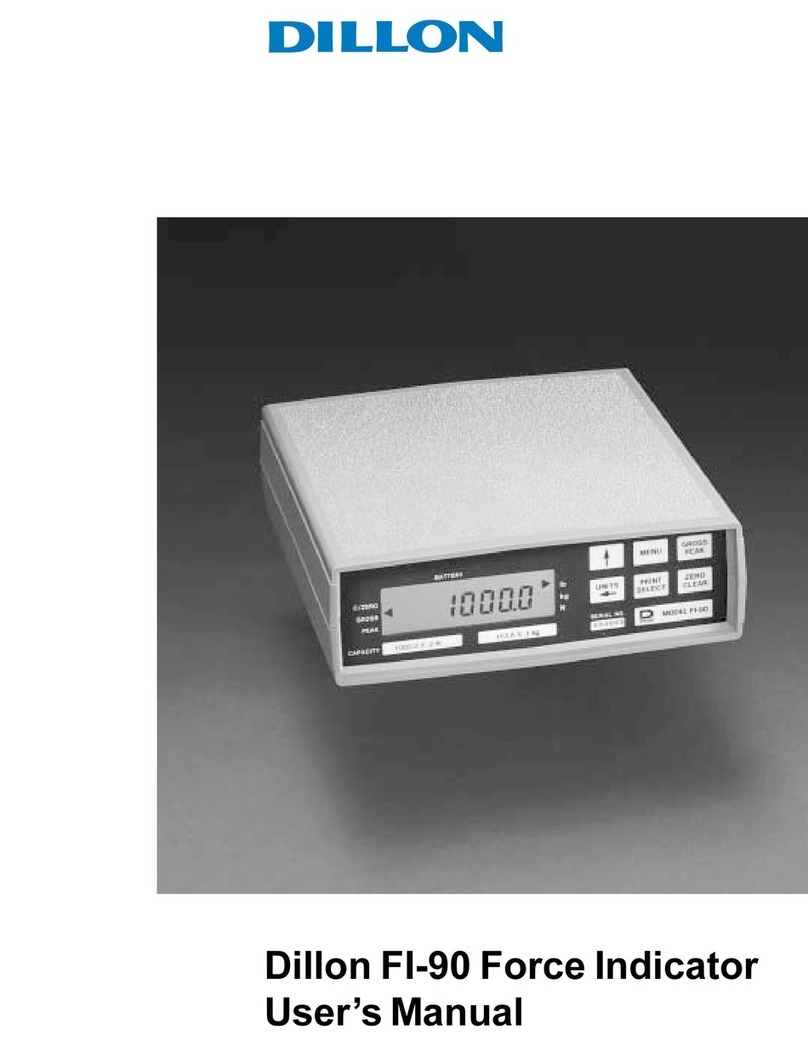
Dillon
Dillon FI-90 User manual
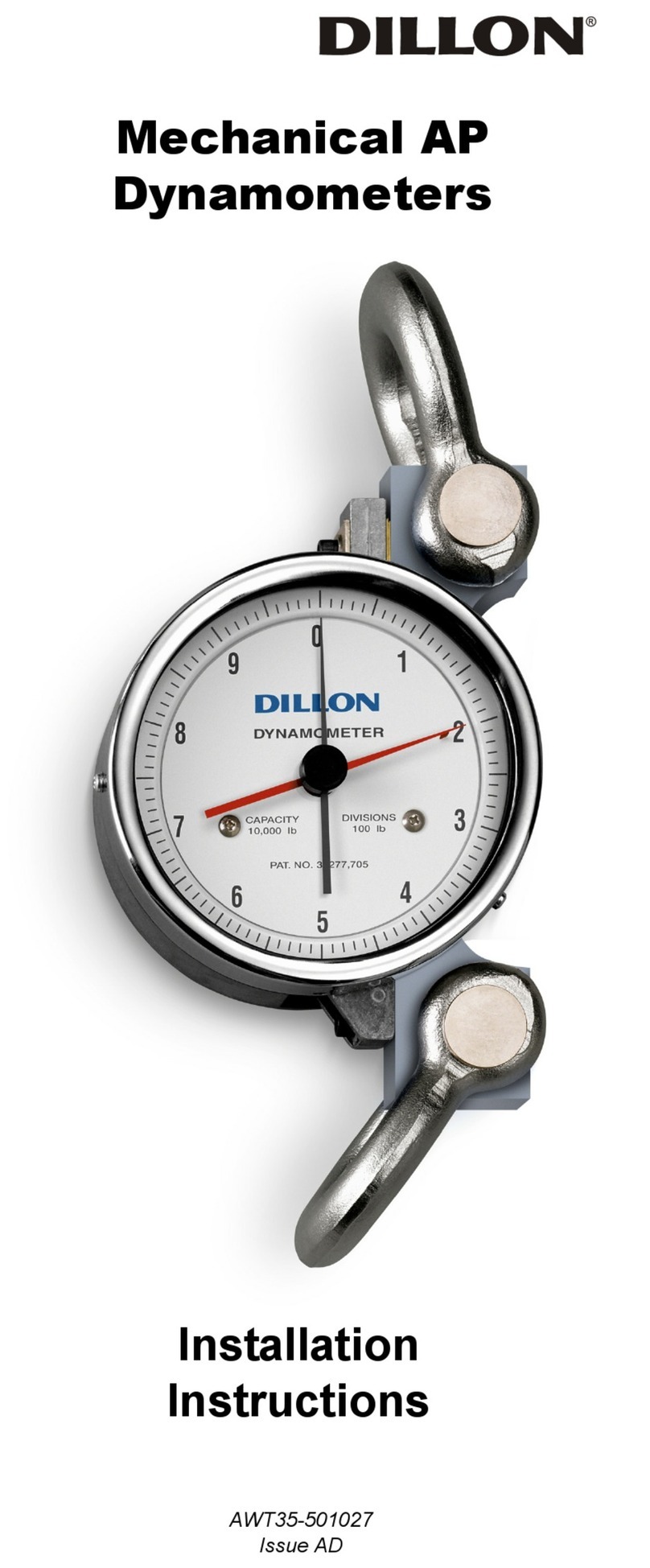
Dillon
Dillon AP Dynamometer User manual
